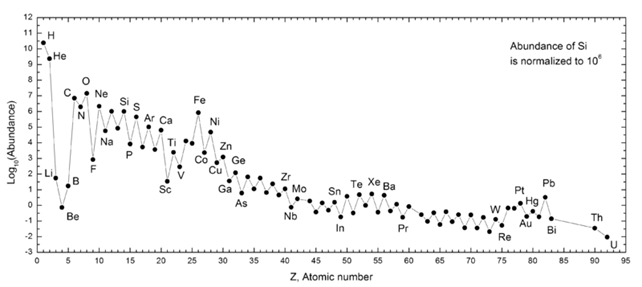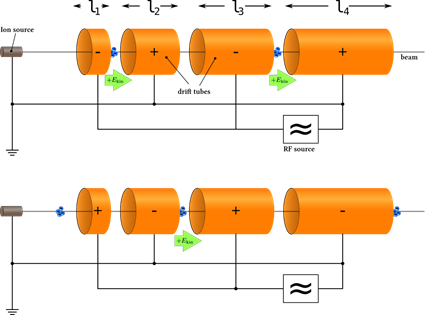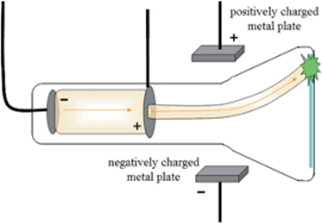
A machine used in nuclear astrophysics experiments to accelerate charged particles.
A particles accelerator uses an electric field to accelerate charged particles almost to the velocity of light. The particles travel forming a beam inside a tube in vacuum condition. The beam has to reach a target magnets are used to focus it. The products of the particles collisions with the target are analyzed with detectors.
Accelerators were invented in the 1930s with the aim of investigating the atomic structure, and are used in basic and applied research. There are more than 30,000 accelerators in the world. The most powerful are used to study the properties of nuclei and subatomic particles and to try to understand the origin of the Universe. Many accelerators find application in the field of medicine, for example in radiotherapy for the treatment of tumors, or in industry and in the production of materials. Accelerating particles means giving them kinetic energy, but not only that. As Einstein taught us with his famous equation E=mc2, energy and mass are two sides of the same coin. Therefore, by making very energetic particles collide it is possible to generate greater masses, or at any rate particles that are different from the original ones. Physical research studies the properties (e.g. mass, charge, etc.) of what is produced from colliding accelerated particles and "target" particles. Researchers try to figure out what kind of reactions happen in these collisions and the role of the fundamental forces.

Fig.1 Graph of the abundance of elements in the Solar System. (Credits: Wikimedia Commons).
Particles can only be accelerated if they have an electric charge, because in order to accelerate them there needs to be an electric field. For example, you can accelerate protons, which have a positive electrical charge, or electrons, which are negatively charged. We speak of electrostatic or electrodynamic accelerators, depending on the type of electrical field applied. The accelerator used in the LUNA experiment at the Gran Sasso National Laboratory, is an example of the first type: the particle beam is accelerated by passing, only once, through a space where there is a large difference in electrical potential which can be maintained and which does not vary over time (i.e. a static electric field). Electrostatic accelerators are simpler and cheaper to build. In electrodynamic accelerators the beam passes through accelerating fields several times. Acceleration is obtained by placing cylindrical electrodes of variable length around the beamline and applying an alternating electrical voltage to them (Fig.1). This alternating voltage ensures that the particles always have in front of them an oppositely charged field of force, with respect to their charge, thus attracting and consequently accelerating them. As the beam advances, it encounters longer and longer electrodes, which maintain the beam "in phase" by means of alternating the electric field. In fact, with each acceleration particles increase their speed and travel a greater distance during fixed voltage reversal time. For very high energy accelerators, these electrodes are replaced by resonant cavities, cylinders in which electromagnetic waves are formed which "push" the particles, thus accelerating them.

Diagram of the operation of a linear accelerator. In the lower part, the negatively charged particles (shown in blue) are extracted from a source (ion source) and accelerated towards a positive voltage electrode. Exiting from the electrode (figure above) a source which typically operates at radio frequency (RF source) reverses the voltage of the electrodes, causing the particles to accelerate forwards again, and so on. The electrodes are of increasing length because at each acceleration the particles travel a greater distance during the time it takes the radio frequency source to change the voltage. (Credits: Wikimedia Commons)
An essential condition in any type of accelerator is the creation of vacuum: if the beam encounters other particles along its path, it can disperse or lose energy by colliding with them. It must also be "focused", i.e. very compact. This is because it must generate as many collisions as possible within a very small target area. To “focus” it we use electromagnets inserted along the accelerator. These magnets produce a varying magnetic field by passing through an electric current. Other magnets can be used instead to direct the beam, for example to direct it against targets positioned in different places.
Gli Electrodynamic accelerators are further divided into two types, depending on the type of path of the accelerated particles. In linear accelerators the particles run through the vacuum tube only once and the path is linear. In circular accelerators, the beam can travel along the orbit several times. Such an orbit is obtained by positioning powerful electromagnets at regular intervals along a circumference. At each passage the beam is accelerated, but for this to happen the electromagnets must increase the power of the magnetic field each time, synchronizing with the increasing kinetic energy of the particles. Therefore, today's circular accelerators are called synchrotrons. When the particles have reached the energy required, they are made to collide with another beam that travels in the opposite direction or with a target that is inserted along the path. The traces and/or the energy of the particles and the radiation produced by the collisions between beam and target are measured with a detector. Both linear and circular accelerators can have very different dimensions. The first circular accelerators, which are called cyclotrons, different from those described here, had only a radius of tens of centimeters. Synchrotrons, on the other hand, can have impressive dimensions: the largest in the world has a radius of more than 4 km. This is the Large Hadron Collider (LHC) and is located at CERN in Geneva (Switzerland). In the same way a linear accelerator can be only a few centimeters long, like the length of a cathode ray tube ("heart" of the televisions sold up until 2000; Fig.2) or several kilometers in length, as in the case of the Stanford Linear Accelerator Center (SLAC) in the United States, which is more than 3 Km long. Generally, the greater the length of the accelerator, the greater the level of energy reached. This energy is measured in electron volts (eV), a unit of measurement that represents the energy gained by a particle. In particular, 1 eV corresponds to the energy gained by an electron moving in a vacuum between two points to which an electrostatic potential difference of 1 Volt is applied. The highest level of energy recorded so far belongs to the Large Hadron Collider, which collided two beams of protons at the energy of 13 TeV (teraelectronvolt) i.e. 13 trillion electron volts.

Fig.2 Diagram of a cathode ray tube, like the ones used to project images in TV sets produced until the beginning of the 2000s. Some electrons are accelerated by an electrostatic field (left) and then deflected by an electric field created by the two metal plates (positively and negatively charged) towards a screen coated with fluorescent material, which emits light when hit by the electrons. (Credits: Wikimedia Commons)

Discover the experiments and help the alien to get back home!
Play now